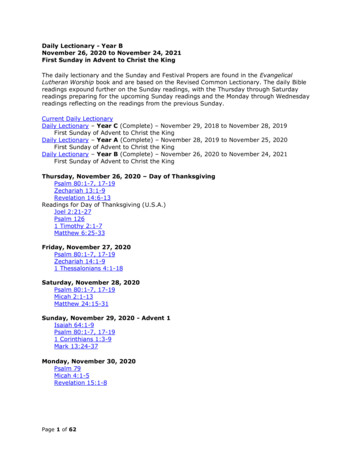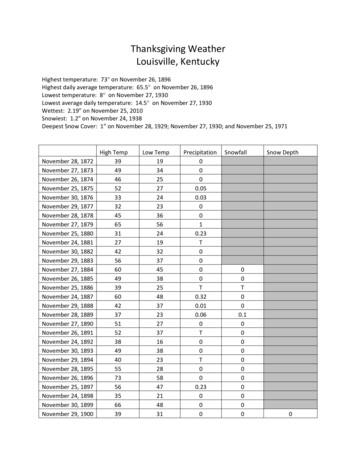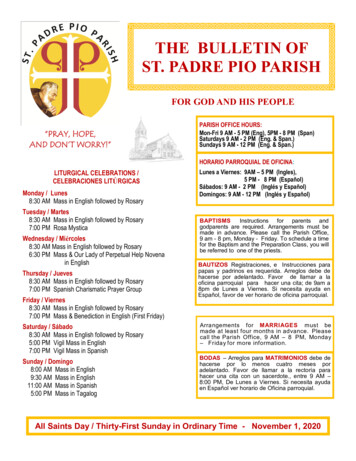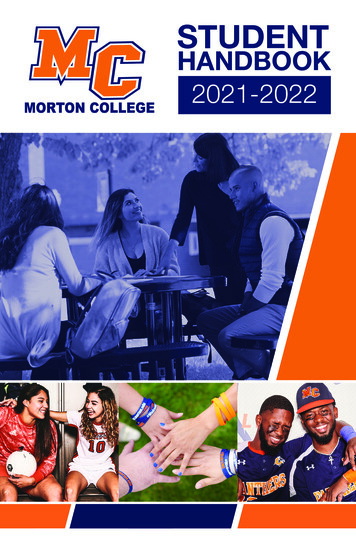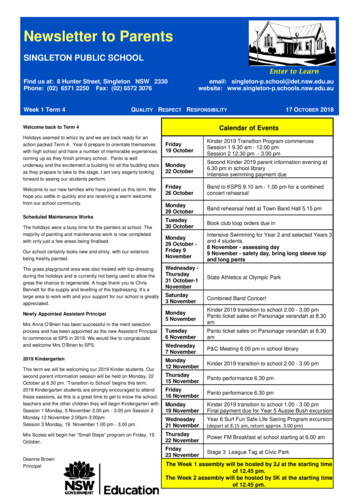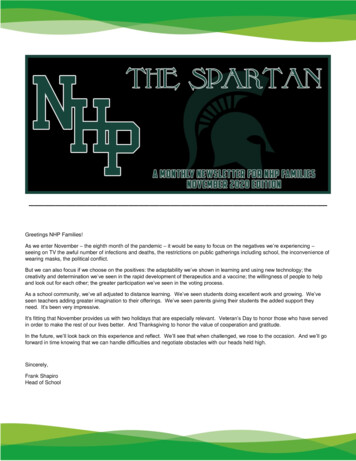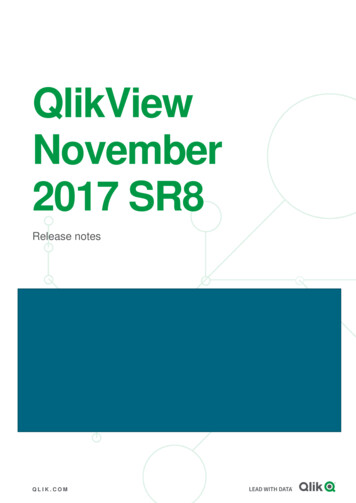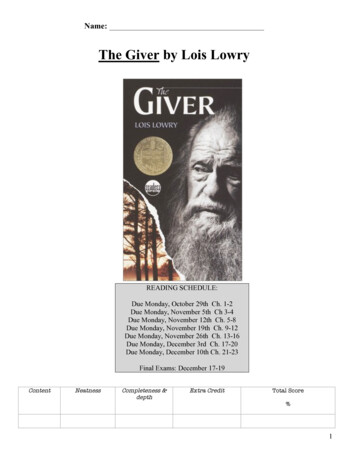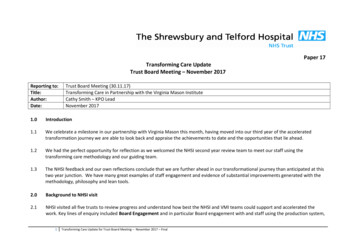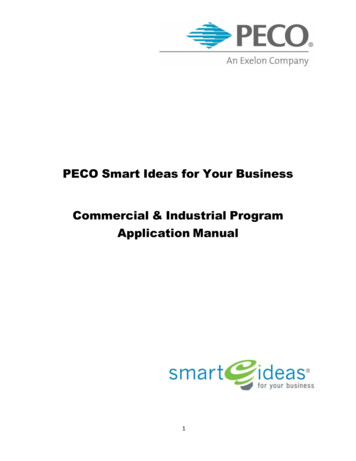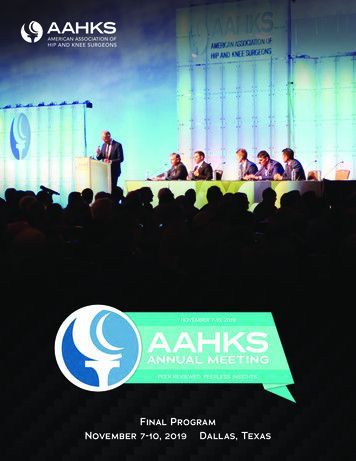
Transcription
Final ProgramNovember 7-10, 2019 Dallas, Texas
LeadershipBOARD OF DIRECTORSPatient and Public Relations: Brett R. Levine, MD, MSPresidentMichael P. Bolognesi, MDPractice Management: Louis S. Stryker, MDFirst Vice PresidentC. Lowry Barnes, MDPublications: Samuel S. Wellman, MDSecond Vice PresidentRichard Iorio, MDResearch: Javad Parvizi, MD, FRCSThird Vice PresidentBryan D. Springer, MDYoung Arthroplasty Group: Jeffrey K. Lange, MDImmediate Past PresidentCraig J. Della Valle, MDProgram: James A. Browne, MDQuality Measures: William G. Hamilton, MDWomen in Arthroplasty: Audrey K. Tsao, MDPROGRAM COMMITTEEPast PresidentMark I. Froimson, MD, MBAJames A. Browne, MD, ChairSecretaryGregory G. Polkowski II, MD, MScJeremy M. Gililland, MDTreasurerRyan M. Nunley, MDMembers-At-LargeJames A. Browne, MDAntonia F. Chen, MD, MBARobert M. Molloy, MDMark J. Spangehl, MDCOUNCIL CHAIRSMatthew P. Abdel, MDWilliam B. Macaulay, Jr., MDR. Michael Meneghini, MDGregory G. Polkowski II, MD, MScBryan D. Springer, MDLucian C. Warth, MDSUBMISSION REVIEWERSJeffrey A. Ackerman, MDMuyibat A. Adelani, MDEdward M. Adler, MDHealth Policy Council: James I. Huddleston III, MDAjay Aggarwal, MDEducation and Communications Council:Oluwaseun Akinbo, MDBryan D. Springer, MDMembership Council: Mark J. Spangehl, MDDerek F. Amanatullah, MD, PhDMichael P. Ast, MDMatthew S. Austin, MDCOMMITTEE CHAIRSAdvocacy: James I. Huddleston, MDCommittee on Committees: C. Lowry Barnes, MDDigital Health and Social Media: Stefano A. Bini, MDEducation: Joseph T. Moskal, MD, FACSEvidence-Based Medicine: Matthew S. Austin, MDFellowship Match Oversight: Michael J. Taunton, MDFinance: Ryan M. Nunley, MDHumanitarian: Harpal S. Khanuja, MDIndustry Relations: Lucian C. Warth, MDInternational: Rafael J. Sierra, MDLeadership Development: Jay R. Lieberman, MDMembership Outreach: Thomas L. Bradbury, MDNominating: Craig J. Della Valle, MDwww.AAHKS.org/MeetingTrevor R. Banka, MDHany S. Bedair, MDJaime L. Bellamy, DODon C. Beringer, MDHari P. Bezwada, MDRussell J. Bodner, MDKevin J. Bozic, MD, MBAThomas E. Brown, MDMatthew W. Bullock, DOFrank A. Buttacavoli, MDPaul C. Buzhardt, MDAntonia F. Chen, MD, MBADarwin D. Chen, MDHerbert J. Cooper, MD1
LeadershipDavid A. Crawford, MDErik W. Kroger, MDBrian M. Culp, MDChad A. Krueger, MDBrian M. Curtin, MD, MSYoung-Min Kwon, MD, PhDDavid F. Dalury, MDClaudette M. Lajam, MDChris J. Dangles, MDJason E. Lang, MDCharles M. Davis, III, MD, PhDMaxwell K. Langfitt, MDDaniel John Del Gaizo, MDEric A. Levicoff, MDMatthew J. Dietz, MDBrett R. Levine, MD, MSJacob M. Drew, MDJess H. Lonner, MDStephen T. Duncan, MDTad M. Mabry, MDRobert Easton, MDTheodore T. Manson, MDKarim A. Elsharkawy, MDJoseph D. Maratt, MDOrry Erez, MDJ. Bohannon Mason, MDAidin Eslam Pour, MDVasilios Mathews, MDThomas K. Fehring, MDBenjamin A. McArthur, MDMichael J. Feldstein, MD, MSD. Clinton McNabb, MDStuart J. Fischer, MDSimon C. Mears, MD, PhDMichael A. Flierl, MDMichael A. Mont, MDMark G. Freeman, MDVincent M. Moretti, MDKevin B. Fricka, MDMichael J. Morris, MDJonathan P. Garino, MDWayne E. Moschetti, MD, MSDevon D. Goetz, MDJoseph T. Moskal, MD, FACSJeffrey M. Goldstein, MDColin A. Mudrick, MDGregory J. Golladay, MDThomas G. Myers, MDJoseph S. Gondusky, MDDenis Nam, MD, MScAlexander C. Gordon, MDSumon Nandi, MD, FACSChristopher W. Grayson, MDNader A. Nassif, MDBrian R. Hamlin, MDNathaniel J. Nelms, MDShane R. Hess, DOCharles L. Nelson, MDCarlos A. Higuera, MDTrevor North, MDJames I. Huddleston, MDRyan M. Nunley, MDJason R. Hull, MDHari K. Parvataneni, MDRina Jain, MD, FRCSCJavad Parvizi, MD, FRCSDerek R. Jenkins, MDChristopher E. Pelt, MDJason M. Jennings, MDBrett C. Perricelli, MDSeth A. Jerabek, MDKevin I. Perry, MDDavid S. Jevsevar, MD, MBAKevin D. Plancher, MDAtul F. Kamath, MDMihail Radulescu, MDMark S. Karadsheh, MDAdam J. Rana, MDJames A. Keeney, MDHarold W. Rees, MDStephen J. Kelly, MDBenjamin F. Ricciardi, MDBrian A. Klatt, MDAndrew B. Richardson, MDDavid J. Kolessar, MDDavid Rodriguez, MD22019 AAHKS Annual Meeting Final Program
LeadershipAlexander P. Sah, MDSTAFFAdam A. Sassoon, MD, MSMichael J. Zarski, JD,Arjun Saxena, MDJonathan L. Schaffer, MD, MBAH. Del Schutte, Jr., MDAdam J. Schwartz, MDBenjamin Schwartz, MDRan Schwarzkopf, MD, MScPeter K. Sculco, MDChristopher E. Selgrath, DOThorsten M. Seyler, MD, PhDRoshan P. Shah, MDVivek M. Shah, MDCambize Shahrdar, Jr., MDRafael J. Sierra, MDJames D. Slover, MDMark J. Spangehl, MDJonathon M. Spanyer, MDScott M. Sporer, MD, MSJeffrey B. Stambough, MDGaren D. Steele, MDBenjamin M. Stronach, MD, MSLouis S. Stryker, MDExecutive DirectorJoshua Kerr,Deputy Executive DirectorSharon M. Creed,Accounting and Registration ManagerNatalie Loper,Project SpecialistEileen M. Lusk,Senior Director of MembershipRenalin J. Malvar-Ledda,Director of OperationsJeff Mitchell,Director of Marketing and Corporate RelationsChiara Rodgers, MPH, CCRC,Director of Research and Humanitarian ActivitiesPatti Rose,Membership SpecialistDenise Smith Rodd,Senior Communications SpecialistSigita Wolfe,Senior Director of Education and ScienceJuan C. Suarez, MDT. David Tarity, MDMichael J. Taunton, MDKrishna R. Tripuraneni, MDCreighton C. Tubb, MDKimberly K. Tucker, MDJonathan M. Vigdorchik, MDFrank R. Voss, MDJoseph P. Ward, MDJonathan E. Webb, MDSamuel S. Wellman, MDAdolph J. Yates Jr., MD, FAOAKhalid M. Yousuf, MDMark W. Zawadsky, MDwww.AAHKS.org/Meeting3
EducationEDUCATIONAL ACTIVITY SCOPEDISCLAIMERThe 2019 AAHKS Annual Meeting is designed to providepracticing orthopaedic surgeons with research based,state-of-the-art information on diagnosis, surgical andnon-surgical treatment options and overall management ofhip and knee conditions. This educational activity includesthe review of the most current scientific research studyfindings, faculty and participant discussions and interactivesymposia. It covers multiple clinical topics such as primaryand revision total hip arthroplasty, primary and revision totalknee arthroplasty, non-arthroplasty, infection, complicationsother than infection as well as health policy. It is aimed atimproving overall surgeon competence related to the careof patients with arthritis and degenerative disease.The material presented at this Annual Meeting has beenmade available by AAHKS for educational purposes only.This material is not intended to represent the only, nornecessarily the best methods or procedures appropriatefor the medical situations discussed; but rather, is intendedto present an approach, view, statement or opinion of thefaculty, which may be helpful to others who face similarsituations. AAHKS disclaims any and all liability for injuryor other damages resulting to any individual attending acourse and for all claims, which may arise out of the use ofthe techniques, demonstrated there in by such individuals,whether these claims shall be asserted by a physician orany other person.OBJECTIVESCONTENT AGREEMENTUpon completion of this educational activity, participantswill be able to:By attending the Annual Meeting, participantsacknowledge and agree that AAHKS and / or its agentsmay record the Program and related events, use audioand video recordings, photographs and presentationmaterials such as slides and abstracts for AAHKS’spurposes, including but not limited to other educationalproducts, news, advertising and promotional purposes,without compensation. ynthesize the most current research study findings in Ship and knee condition management valuate various surgical and non-surgical treatment Eoptions (e.g., primary total joint arthroplasty, revisiontotal joint arthroplasty, non-arthroplasty) in hip and kneecondition management A ssess the efficacy of new treatment options throughevidence-based data Interpret relevant healthcare policyACCREDITATION AND CME CREDITThe American Association of Hip and KneeSurgeons (AAHKS) is accredited by theAccreditation Council for Continuing MedicalEducation (ACCME) to provide continuing medicaleducation for physicians.The American Association of Hip and Knee Surgeons(AAHKS) designates this live activity for a maximum of18 AMA PRA Category 1 Credits . Physicians shouldclaim only the credit commensurate with the extent of theirparticipation in the activity.FDA STATEMENTSome pharmaceuticals and / or medical devicesdemonstrated at the Annual Meeting have not beencleared by the US Food and Drug Administration (FDA)or have been cleared by the FDA for specific purposesonly. The FDA has stated that it is the responsibility of thephysician to determine the FDA clearance status of eachpharmaceuticals and / or medical device he or she wishesto use in clinical practice. The AAHKS policy provides that“off label” status of the device or pharmaceutical is alsospecifically disclosed (i.e. that the FDA has not approvedlabeling the device for the described purpose). Any deviceor pharmaceutical is being used “off label” if the describeduse is not set forth on the product’s approved label.CLAIM CME CREDITSAAHKS will send an email with a meeting evaluationupon conclusion of the Annual Meeting. At the end of theevaluation, there will be a link to claim CME credit. It is themeeting attendee’s responsibility to claim credits based onthe hour-for-hour participation actually spent in theeducational activity.42019 AAHKS Annual Meeting Final Program
EducationDISCLOSUREEducationalGrantsAAHKS wishes to thankDePuy SynthesSmith & NephewStrykerZimmer BiometFor their generouseducational grantsthat make the AnnualMeeting possible.www.AAHKS.org/MeetingEach participant in the Annual Meeting has been asked todisclose if he or she has received something of value froma commercial company or institution, which relates directlyor indirectly to the subject of their presentation. These arethe disclosure categories: Nothing to disclose Royalties from a company or supplier S peakers bureau / paid presentations for a companyor supplier Paid employee for a company or supplier Paid consultant for a company or supplier Unpaid consultant for a company or supplier Stock or stock options in a company or supplier Research support from a company or supplier as a PI O ther financial or material support from a companyor supplier Royalties, financial or material support from publishers M edical / Orthopaedic publicationseditorial / governing board Board member / committee appointments for a societyAn indication of the participant’s disclosure appears afterhis or her name as well as the commercial company orinstitution that provided the support. AAHKS does not viewthe existence of these disclosed interests or commitmentsas necessarily implying bias or decreasing the value of theauthor’s participation in the course. Disclosures can befound in the back of this program and atwww.AAHKS.org/Meeting.5
Dr. Hofmann to Receive the 2019AAHKS Humanitarian AwardPresenting the 2019 AAHKS Humanitarian Award to Aaron A. Hofmann, MDAaron A. Hofmann, MD has been selected as the 2019 American Association of Hip andKnee Surgeons (AAHKS) Humanitarian Award recipient. Dr. Hofmann, who is a 1991charter member of AAHKS, founded Operation Walk Utah 15 years ago after travelingon an Operation Walk mission with Lawrence D. Dorr, MD to Guatemala. The focus ofOperation Walk Utah is the Hospital Nacional Santa Tecla in El Salvador where more than800 patients are on a waiting list for hip and knee replacement surgeries. Dr. Hofmanntravels with his team twice a year and sees 55-70 patients on each trip.Each year, Dr. Hofmann invites one trainee from El Salvador to his clinic for a six-weekfellowship. The trainee then returns with the Operation Walk Utah team to El Salvador tohelp screen and operate on their patients. He is currently working with AAHKS and theOperation Walk Central Board to establish a training center in El Salvador to teach localsurgeons how to perform hip and knee replacement surgery. Dr. Hofmann is also workingwith the Minister of Health and Salvadorian President to establish a joint center with localsurgeons in order to help shorten the long wait list for joint replacement.Erin Hofmann told the story of how her father not only has performed more than 1,000surgeries for Salvadorians in need, but how he also stepped in when the program lost itsstorage room due to the hospital’s need for the space. “My dad traveled to San Salvadorfor 36 hours on a weekend in between his own surgeries and clinics. He showed upwith one other OpWalk volunteer, building materials and a local workforce to moveequipment, pour concrete and stack cinder blocks. The storage shed they built solidifiesthe commitment to return to El Salvador for many years to come.”According to Dr. Dorr, “Aaron’s work has sparked other Operation Walk chapters in atleast eight states. No other Operation Walk Surgeon has invested so much personalmoney or demonstrated such entrepreneurial enthusiasm for improving his team’s deliveryof care to people who would otherwise remain disabled throughout their lives.”The AAHKS Humanitarian Award recognizes AAHKS members who have distinguishedthemselves by providing humanitarian medical services and programs with a significantfocus on musculoskeletal diseases and trauma including the hip and knee in the UnitedStates or abroad.Nominations for the 2020 AAHKS Humanitarian Award are now being accepted throughApril 15, 2020 at www.AAHKS.org/Humanitarian.62019 AAHKS Annual Meeting Final Program
Paper #1No Difference in Survivorship or Functional Outcome Between SurgeonPreference for Computer Assisted Navigation vs. Conventional Instrumentationin 19,221 Total Knee Arthroplasties at 12 yearsTimothy Roberts, MBChB, Simon W. Young, MBChB, FRACS, MDIntroduction: This study compares the revision ratesand functional outcomes of total knee arthroplasty (TKA)implanted using computer-assisted surgery (CAS) withconventional instrumentation from a large national databaseat up to 12 years follow-up. Recognizing that selection biasmay arise from the preferential use of CAS in difficult orcomplex cases, the implant survival data and postoperativefunctional scores were analyzed with reference to whetherthe surgeon routinely implanted TKA using CAS orconventional instrumentation.NotesMethods: Revision rates and functional data in terms ofOxford Knee Questionnaire (OKQ) scores at six months,five years and ten years were obtained for 19,221TKAs implanted between 2006 and 2018 from the NewZealand Joint Registry (NZJR). This data was analyzedcomparing two patient cohorts: 1) those treated by highvolume surgeons who implanted using CAS for 90%of TKAs (“routine CAS”); and 2) those treated by highvolume surgeons using CAS for 10% of TKAs (“routineconventional”).Results: After 12 years, the revision rate per 100component years was 0.437 for the “routine CAS”surgeons compared to 0.440 for the “routine conventional”surgeons (p 0.734). For patients under the age of 65, therevision rate per 100 component years was equivalent for“routine CAS” surgeons compared to “routine conventional”surgeons (0.585 vs. 0.508, p 0.524). The OKQ scoreswere similar at six months (38.88 vs. 38.52, p 0.172), fiveyears (42.26 vs. 41.77, p 0.206) and ten years (41.59vs. 41.74, p 0.893) when comparing the two cohorts.Surgeons who performed more than 50 TKAs using CAStook 13 minutes longer on average than those usingconventional instrumentation (89 minutes vs. 76 minutes,p 0.001).Conclusions: We found no difference in implant survivalbetween CAS and conventional instrumentation systems,even when controlling for potential surgeon bias of usingCAS in only difficult cases.www.AAHKS.org/Meeting7
Paper #2Functional Gain and Pain Improvement After Primary Total Knee ReplacementAre Influenced by Patient Characteristics and Not Implant ManufacturerAdam W. Green, MD, Kyle Alpaugh, MD, Hua Zheng, PhD, Wenyun Yang, MS,Patricia D. Franklin, MD, MPH, David C. Ayers, MDIntroduction: Implant selection is largely based oninstitutional factors, surgeon training, and preference.International registries compare relative revision rates byimplant but do not assess functional outcomes. We soughtto quantify and compare functional outcomes by implantmanufacturer. We compared pre-post primary total kneereplacement (TKR) pain improvement and functional gainat 12 months in a contemporary multi-site patient cohortto determine if patient-reported gains differ among implantmanufacturers.NotesMethods: 9,818 patients (mean age 65.8 years, 65%females) received implants by Stryker, Zimmer Biomet,Smith & Nephew or DePuy. Preoperative demographicsincluding medical (modified Charlson), musculoskeletal,and emotional (SF; MCS) comorbidity data were collectedand merged with pre- and post-TKR pain and function(KOOS pain and ADL) scores from each patient. Descriptivestatistics, kernel density curves, and multivariable linearmodels, adjusted for variation within site, were performed.Statistical significance was set at p 0.05.Results: Manufacturer A, B, C and D implants were usedin 5,658, 2,202, 1,283, and 675 patients respectively. Themajority reported excellent pain relief and functional gainsacross implants. Across implant manufacturers, pre-postimprovements in KOOS knee pain scores were comparable(A 35.6, B 35.8, C 35.9, D 34.3). Similar improvementswere seen in KOOS ADL scores across all implants(A 30.9, B 30.5, C 30.2, D 28.3). In multivariable modelsadjusting for patient covariates, implant manufacturer wasnot significantly associated with postoperative pain orfunction. However, patient factors (older age, non-whiterace, smoker, low back pain, pain in non-operative hips/knees, low MCS) are associated with significantly (p 0.05)poorer gains in pain and function.Conclusions: Multiple different implants are usedfor primary TKR. No differences in postoperative painimprovement or functional gain at 12 months were seenbetween implant manufacturers. However, patient factorscontinue to significantly influence gains in postoperativepain and function.82019 AAHKS Annual Meeting Final Program
Paper #3The Cumulative Effect of Depression and Substance Abuse on PostoperativeComplications After Primary Total Knee ArthroplastyLuke J. Garbarino, MD, Peter A. Gold, MD, Hiba Anis, MD, Nipun Sodhi, MD, Jonathan R. Danoff, MD,Sreevathsa Boraiah, MD, Vijay J. Rasquinha, MD, Michael A. Mont, MDIntroduction: Substance abuse, alcohol abuse anddepression have individually been shown to negativelyaffect total knee arthroplasty (TKA) outcomes. However,their cumulative effect on postoperative complications hasnot been well elucidated. Therefore, this study aimed todetermine the impact of depression, substance abuse andalcohol abuse on postoperative complications followingTKA.NotesMethods: TKA patients were prospectively followed at15 hospitals in a large health system between 2017 and2019. Patients with depression, substance abuse andalcohol abuse were identified using diagnosis codes.Variables collected were patient demographics, medicalcomorbidities, prosthetic joint infections (PJI), urinary tractinfections, cellulitis, periprosthetic fractures, instabilities,implant failures, osteolyses and thromboemboli. Univariateanalysis and multivariate analyses were performed toidentify the combinations of mental health disordersassociated with complications.Results: 11,403 TKA patients were identified: 1,536 witha history of depression, 591 with a history of substanceabuse and 91 with a history of alcohol abuse. Univariateanalysis showed that depression was associated withimplant failures (p 0.001) and alcohol abuse with PJIs(p 0.001) and deep vein thromboses (p 0.003). Substanceabuse was associated with PJI (p 0.001), woundcomplications (p 0.022) and implant loosening (p 0.007).Multivariate analyses found that alcohol abuse (OR: 19.419,p 0.001), substance disorder (OR: 3.693, p 0.010), anddepression plus substance (OR: 13.639, p 0.001) wereassociated with PJIs. Additionally, depression plus alcohol(OR: 26.616, p 0.000) and depression plus substanceabuse (OR:4.401, p 0.021) were associated with cellulitis.Conclusions: Patients with depression, substanceabuse or alcohol abuse were found to be at greater risk ofpostoperative complication. In combination, the cumulativeeffect of depression and abuse was found to be far morelikely to be associated with both PJI and cellulitis than iffound in isolation. The results of this study can help identifythose patients who are at greater risk for postoperativecomplications in order to enable improved preoperativeoptimization and patient education.www.AAHKS.org/Meeting9
Paper #4Preoperative Behavioral Pain Management Strategies in Total JointArthroplasty: A Prospective Randomized Controlled Trial ComparingMindfulness, Hypnosis and Cognitive-Behavioral PsychoeducationAdam Hanley, PhD, Eric Garland, PhD, Jeremy M. Gililland, MD, Christopher E. Pelt, MD,Lucas A. Anderson, MD, Christopher L. Peters, MD, Jill A. Erickson, PA-CIntroduction: To better support patients’ recovery aftertotal joint arthroplasty (TJA), we introduced evidencebased, preoperative behavioral pain management strategiesto our existing multi-modal pain management protocol.This study examined the effect of three different adjunctiveinterventions (mindfulness meditation, hypnotic suggestion,cognitive-behavioral psychoeducation) on preoperative painand anxiety as well as physical function in early recoveryfollowing primary TJA.NotesMethods: This was a three-arm, prospective randomizedcontrolled trial conducted in a university-based orthopaedicpractice. Patients (N 288: knee 185, hip 103) attendinga preoperative education class were randomized to oneof three 15-minute interventions: mindfulness (n 108),hypnosis (n 90), or psychoeducation (n 90). A briefsurvey measured pain-at-rest, desire for pain medication,and anxiety immediately before and 15 minutes after thepreoperative intervention. Additionally, preoperative and6-week postoperative PROMIS Physical Function (PF)scores were compared.Results: Linear mixed modeling, adjusted for age, BMI,and comorbidities, revealed that mindfulness and hypnosissignificantly reduced preoperative pain intensity by 24%and 26% respectively (p 0.001), pain unpleasantness by29% and 33% (p 0.001), and anxiety by 43% and 29%(p 0.001). Preoperative mindfulness training significantlyincreased PROMIS PF scores from patients’ preoperativeto 6-week postoperative visit ( 5.62, p 0.001, MCID 3.34)relative to hypnosis and psychoeducation, which showedno significant change from preoperative to 6 weeks.Conclusions: Findings from this study suggest that asingle, 15-minute mindfulness or hypnosis interventionimmediately reduced preoperative pain intensity, painunpleasantness, and anxiety in patients preparing for TJA.Historically, we have found no significant improvementin PROMIS PF scores 6 weeks after TJA; whereas, withpreoperative mindfulness training, we found clinicallyand statistically significant improvements in self-reportedphysical function at 6-weeks postoperatively. These findingssuggest that brief, preoperative mindfulness training maybe an effective adjunct that can be easily disseminated inclinical settings, provide immediate preoperative pain andanxiety relief, and may improve postoperative physicalfunction.102019 AAHKS Annual Meeting Final Program
Paper #5The Effect of the IPACK Block on Pain Following Primary TKA:A Double Blinded, Prospective, Randomized TrialJillian Vitter, MD, George F. Chimento, MD, Kim Bland, MD, Bobby Nossaman, MD,Leslie Thomas, MD, Matthew Patterson, MDIntroduction: Regional anesthesia is utilized to minimizepostoperative pain following total knee arthroplasty(TKA). The purpose of this this study was to determineif preoperative infiltration of local anesthetic between thepopliteal artery and posterior capsule of knee (IPACK)controlled posterior knee pain following TKA.NotesMethods: IRB approval was obtained and a power analysiswas performed. Patients were randomized into one oftwo treatment arms: 1) continuous adductor canal block(ACB) with IPACK block (IPACK Group), or 2) continuousACB with sham subcutaneous saline injection (No IPACKGroup). Only the anesthesiologist performing the block wasaware of randomization status. Following surgery, a blindedmedical assessor recorded opioid consumption, painscores, and gait distance.Results: There were 35 people in the IPACK group and34 in the NO IPACK group. There was no differencedemographically between the groups. In the PostAnesthesia Care Unit (PACU), the average (P 0.0122) andworst (P 0.0168) pain scores at rest were statistically (butnot clinically) significant, with lower scores in the IPACKgroup. There was no difference in the pain scores duringphysical therapy (P 0.2080). There was no difference inopioid consumption in the PACU (P 0.7928), or at 24hours (P 0.7456). There was no difference in pain scoreson POD 1 in the morning (a.m.) (P 0.4597) or evening(p.m.) (P 0.6273), nor was there any difference in walkingdistance (P 0.5197). There was also no difference in lengthof stay in the PACU (P 0.9426) or hospital (P 0.2141).Conclusions: The IPACK group had lower pain scores atrest in the PACU, but this was not clinically significant. Theroutine use of the IPACK Block is not supported by theresults of this study. There may be use of the IPACK blockas a rescue block in patients who have contraindications toa standard multimodal treatment regimen or in patients withchronic pain or opioid dependence.www.AAHKS.org/Meeting11
Paper #6Intraoperative Surgeon Administered Adductor Canal Blockade Is Not Inferiorto Anesthesiologist Administered Adductor Canal Blockade: A ProspectiveRandomized TrialMax R. Greenky, MD, Mikayla E. McGrath, BS, Eric Levicoff, MD, Robert Good, MD,Asim Makhdom, MD, MSc, FRCSC, Jess H. Lonner, MDIntroduction: Controlling pain after total knee arthroplasty(TKA) remains a challenge. A single shot adductor canalblock (ACB) decreases postoperative pain. A specialtytrained anesthesiologist imposes cost and skill barriers.Cadaveric studies and magnetic resonance imagingdata show that access to the adductor canal is possiblefrom within the joint; thus, the potential for intraoperative,surgeon administered ACB through a standard surgicalapproach is feasible. The purpose of this study is tocompare the efficacy of surgeon administered intraoperativeACB to anesthesiologist administered ACB.NotesMethods: Patients undergoing primary TKA wereprospectively randomized to receive either ananesthesiologist administered (Group 1) or surgeonadministered (Group 2) ACB using 15ml of ropivacaine0.5%. Outcomes were pain visual analogue scale (VAS),range of motion, opioid consumption, and patientsatisfaction scores.Results: 51 patients were enrolled (Group 1 28, Group2 23) and followed for a minimum of 6 weeks. There wasno difference in active flexion at postoperative day (POD)0, or 6 weeks (p 0.86, 0.074 and 0.59). There was nodifference in active extension at POD 0, 1, or 6 weeks(p 0.38, 0.07 and p 0.3). Opioid equivalents were equalon POD 0,1, and 2 (p 0.86, 0.68, 0.47). Patients in Group1 had significantly less pain on POD 0 (p 0.014), but therewas no difference in pain VAS score on POD 1 or 2 (p 0.4,p 0.95). There was no difference in patient satisfaction withpain control on POD 0, 1, or 2 (p 0.6, p 0.7, p 0.9).Conclusions: Surgeon administered ACB is not inferiorto anesthesiologist administered ACB with respectto range of motion, patient satisfaction, or opioidconsumption, although pain on POD 0 may be greater.Surgeon administered ACB is an effective alternative toanesthesiologist administered ACB.122019 AAHKS Annual Meeting Final Program
Paper #7Quicker and More Predictable Return of Motor Function and Ambulation AfterMepivacaine vs. Bupivacaine Spinal: A Double-Blind RCT in Primary TKA and THACody C. Wyles, MD, Mark W. Pagnano, MD, Robert T. Trousdale, MD, Rafael J. Sierra, MD,Michael J. Taunton, MD, Kevin I. Perry, MD, Hugh Smith, MD, PhD, Christopher Duncan, MD,Matthew P. Abdel, MDIntroduction: Spinal anesthesia provides several benefitsfor patients undergoing total knee arthroplasty (TKA) andtotal hip arthroplasty (THA), but historically comes at thecost of slower return of lower extremity motor function. Inthis prospective, double-blind, randomized clinical trial, wesought to determine if a mepivacaine spinal would allowsubstantially quicker and more predictable return of motorfunction as compared to traditional low-dose bupivacainespinal anesthesia during primary TKA and THA.NotesMethods: This trial was conducted at a single academicinstitution. Prior to trial initiation, strong internal pilot datadetermined that 154 patients were required to achieve80% power. Patients were randomized in a 1:1 fashion withadvanced computerized stratification based on procedure,sex, age group, and BMI. Following surgery, motorfunction was assessed in the non-operative lower extremityaccording to the Bromage scale and discontinued onceBromage 0 was achieved (spontaneous movement at hip/knee/ankle).Results: Mean time to return of lower extremity motorfunction was 29 minutes quicker and less variable inpatients receiving mepivacaine: 184 minutes (95%CI 168-199 minutes), compared to low-dose bupivacaine:213 minutes (95% CI 184-241 minutes). Mean time tosuccessful participation in physical therapy includingambulation was 20 minutes quicker and less variable inpatients receiving mepivacaine: 399 minutes (95% CI 375423 minutes), compared to low-dose bupivacaine: 419minutes (95% CI 388-451 minutes). The proportion ofpatients experiencing postoperative orthostatic hypotensionor transient neurologic symptoms in those receivingmepivacaine compared to low-dose bupivacaine was 18%vs. 11% and 0% vs. 0%, respectively (non-significant).Conclusions: For patients undergoing primary TKA andTHA, spinal anesthesia with mepivacaine allowed quickerand less variable return of lower extremity motor functioncompared to low-dose bupivacaine, without a conco
2019 AAHKS Annual Meeting Final Program. Education. EDUCATIONAL ACTIVITY SCOPE. The . 2019. AAHKS Annual Meeting is designed to provide practicing orthopaedic surgeons with research based, state-of-the-art information on diagnosis, surgical and non-surgical treatment options and overall management of hip and knee conditions. This educational .
